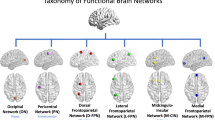Abstract
The current state of label conventions used to describe brain networks related to executive functions is highly inconsistent, leading to confusion among researchers regarding network labels. Visually similar networks are referred to by different labels, yet these same labels are used to distinguish networks within studies. We performed a literature review of fMRI studies and identified nine frequently-used labels that are used to describe topographically or functionally similar neural networks: central executive network (CEN), cognitive control network (CCN), dorsal attention network (DAN), executive control network (ECN), executive network (EN), frontoparietal network (FPN), working memory network (WMN), task positive network (TPN), and ventral attention network (VAN). Our aim was to meta-analytically determine consistency of network topography within and across these labels. We hypothesized finding considerable overlap in the spatial topography among the neural networks associated with these labels. An image-based meta-analysis was performed on 158 group-level statistical maps (SPMs) received from authors of 69 papers listed on PubMed. Our results indicated that there was very little consistency in the SPMs labeled with a given network name. We identified four clusters of SPMs representing four spatially distinct executive function networks. We provide recommendations regarding label nomenclature and propose that authors looking to assign labels to executive function networks adopt this template set for labeling networks.




Similar content being viewed by others
Data Availability
Unthresholded and thresholded statistical maps of the image-based meta-analysis results are available for download from NeuroVault (https://identifiers.org/neurovault.collection:8448).
Code Availability
The NiMARE software used for the image-based meta-analysis results reported in this manuscript is available for download (https://nimare.readthedocs.io/en/latest/index.html; https://github.com/neurostuff/NiMARE).
References
Allen EA, Erhardt EB, Damaraju E et al (2011) A baseline for the multivariate comparison of resting-state networks. Front Syst Neurosci 5:1–23. https://doi.org/10.3389/fnsys.2011.00002
Benjamini Y, Hochberg Y (1995) Controlling the false discovery rate: a practical and powerful approach to multiple testing. J R Stat Soc B 57:289–300
Chen AC, Oathes DJ, Chang C et al (2013) Causal interactions between fronto-parietal central executive and default-mode networks in humans. Proc Natl Acad Sci U S A 110:19944–19949. https://doi.org/10.1073/pnas.1311772110
Corbetta M, Shulman GL (2002) Control of goal-directed and stimulus-driven attention in the brain. Nat Rev Neurosci 3:201–215. https://doi.org/10.1038/nrn755
Gorgolewski KJ, Varoquaux G, Rivera G et al (2016) NeuroVault.org: a repository for sharing unthresholded statistical maps, parcellations, and atlases of the human brain. Neuroimage 124:1242–1244. https://doi.org/10.1016/j.neuroimage.2015.04.016
Goulden N, Khusnulina A, Davis NJ et al (2014) The salience network is responsible for switching between the default mode network and the central executive network: replication from DCM. Neuroimage 99:180–190. https://doi.org/10.1016/j.neuroimage.2014.05.052
Jenkinson M, Bannister P, Brady M, Smith S (2002) Improved optimization for the robust and accurate linear registration and motion correction of brain images. Neuroimage 17:825–841. https://doi.org/10.1016/S1053-8119(02)91132-8
Khasawinah S, Chuang YF, Caffo B et al (2017) The association between functional connectivity and cognition in older adults. J Syst Integr Neurosci 3:1–10. https://doi.org/10.15761/jsin.1000164
Laird AR, Fox PM, Eickhoff SB et al (2011) Behavioral interpretations of intrinsic connectivity networks. J Cogn Neurosci 23:4022–4037
Langenecker SA, Nielson KA, Rao SM (2004) fMRI of healthy older adults during stroop interference. Neuroimage 21:192–200. https://doi.org/10.1016/j.neuroimage.2003.08.027
Nichols T, Das S, Eickhoff S et al (2016) Best practices in data analysis and sharing in neuroimaging using MRI. BioRxiv. https://doi.org/10.1101/054262
Raichle ME (2015) The brain’s default mode network. Annu Rev Neurosci 38:433–447. https://doi.org/10.1146/annurev-neuro-071013-014030
Salimi-Khorshidi G, Smith SM, Keltner JR et al (2009) Meta-analysis of neuroimaging data: a comparison of image-based and coordinate-based pooling of studies. Neuroimage 45:810–823. https://doi.org/10.1016/j.neuroimage.2008.12.039
Salo T, Bottenhorn KL, Nichols TE, et al (2018) NiMARE: a neuroimaging meta-analysis research environment. In: F1000Research. https://doi.org/10.7490/f1000research.1115905.1
Smith SM, Fox PT, Miller KL et al (2009) Correspondence of the brain’s functional architecture during activation and rest. Proc Natl Acad Sci U S A 106:13040–13045. https://doi.org/10.1073/pnas.0905267106
Uddin LQ, Yeo BTT, Spreng RN (2019) Towards a universal taxonomy of macro-scale functional human brain networks. Brain Topogr 32:926–942
Vossel S, Geng JJ, Fink GR (2014) Dorsal and ventral attention systems: distinct neural circuits but collaborative roles. Neurosci 20:150–159. https://doi.org/10.1177/1073858413494269
Yeo BTT, Krienen FM, Sepulcre J et al (2011) The organization of the human cerebral cortex estimated by intrinsic functional connectivity. J Neurophysiol 106:1125–1165. https://doi.org/10.1152/jn.00338.2011
Acknowledgements
The authors wish to extend a sincere thank you to all of the authors who provided their published statistical maps, thus allowing us to perform these analyses. A special thanks go to those authors who went on extended scavenger hunts through their archives in an effort to assist us with our project. ARL, MCR, and TS were supported by NSF 1631325 and NIH R01 DA041353.
Funding
ARL, MCR, and TS were supported by NSF 1631325 and NIH R01 DA041353.
Author information
Authors and Affiliations
Contributions
HvEV, STW, MCR, and ARL conceived of and designed the study. HvEV and STW performed the literature search and collected the published SPMs. TS and MCR contributed scripts, performed meta-analyses, and drafted the figures. HvEV and STW co-wrote the manuscript. All authors contributed to the revisions and approved the final version. HvEV and STW contributed equally to this work.
Corresponding author
Ethics declarations
Conflict of interest
The authors report no conflicts of interest or competing interests.
Additional information
Handling Editor: Glenn Wylie.
Publisher's Note
Springer Nature remains neutral with regard to jurisdictional claims in published maps and institutional affiliations.
Supplementary Information
Below is the link to the electronic supplementary material.
Rights and permissions
About this article
Cite this article
Witt, S.T., van Ettinger-Veenstra, H., Salo, T. et al. What Executive Function Network is that? An Image-Based Meta-Analysis of Network Labels. Brain Topogr 34, 598–607 (2021). https://doi.org/10.1007/s10548-021-00847-z
Received:
Accepted:
Published:
Issue Date:
DOI: https://doi.org/10.1007/s10548-021-00847-z





